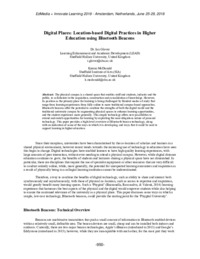Digital Places: Location-based Digital Practices in Higher Education using Bluetooth BeaconsIan Glover, Kieran McDonald
Zu finden in: EdMedia 2018, 2018
|
 |
 Diese Seite wurde seit 6 Jahren inhaltlich nicht mehr aktualisiert.
Unter Umständen ist sie nicht mehr aktuell.
Diese Seite wurde seit 6 Jahren inhaltlich nicht mehr aktualisiert.
Unter Umständen ist sie nicht mehr aktuell.
 Zusammenfassungen
Zusammenfassungen
The physical campus is a shared space that enables staff and students, industry and the public, to collaborate in the acquisition, construction and consolidation of knowledge. However, its position as the primary place for learning is being challenged by blended modes of study that range from learning experiences from fully online to more traditional campus-based approaches. Bluetooth beacons offer the potential to combine the strengths of both the digital world and the traditional university campus by augmenting physical spaces to enhance learning opportunities, and the student experience more generally. This simple technology offers new possibilities to extend and enrich opportunities for learning by exploiting the near-ubiquitous nature of personal technology. This paper provides a high-level overview of Bluetooth beacon technology, along with an indication of some of the ways in which it is developing, and ways that it could be used to support learning in higher education.
Von Ian Glover, Kieran McDonald im Konferenz-Band EdMedia 2018 (2018) im Text Digital Places: Location-based Digital Practices in Higher Education using Bluetooth Beacons  Volltext dieses Dokuments
Volltext dieses Dokuments
 |  Digital Places: Location-based Digital Practices in Higher Education using Bluetooth Beacons: Volltext als PDF ( Digital Places: Location-based Digital Practices in Higher Education using Bluetooth Beacons: Volltext als PDF ( : :  , 266 kByte; , 266 kByte;  : :  2021-03-21) 2021-03-21) |
 Anderswo suchen
Anderswo suchen 
 Beat und dieses Konferenz-Paper
Beat und dieses Konferenz-Paper
Beat hat Dieses Konferenz-Paper während seiner Zeit am Institut für Medien und Schule (IMS) ins Biblionetz aufgenommen. Er hat Dieses Konferenz-Paper einmalig erfasst und bisher nicht mehr bearbeitet. Beat besitzt kein physisches, aber ein digitales Exemplar. Eine digitale Version ist auf dem Internet verfügbar (s.o.). Aufgrund der wenigen Einträge im Biblionetz scheint er es nicht wirklich gelesen zu haben. Es gibt bisher auch nur wenige Objekte im Biblionetz, die dieses Werk zitieren.











 Biblionetz-History
Biblionetz-History